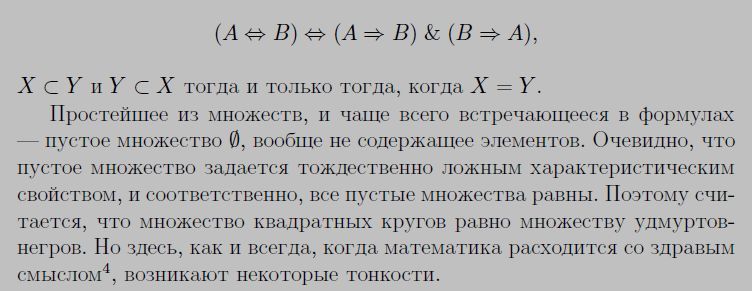No anything
Continuation of logic (there is and is not) with the same name of the article. In this sense: (no something) = (something ≠ something). Here is the python code:
And below is a link to the theory. Quote from the textbook [N. Nepejvoda, Applied Logic, p. 71], in which the empty set is given by the identically false formula.

')
In conclusion, I note that various combinations of these exist and do not allow us to construct a natural series of numbers.
PS A system whose statements can neither be proved nor disproved by the means of the theory itself is called incomplete. On the contrary, a system is called complete if it proves either F, or its negation is proved. And since identically false formulas are excluded from the evidence, it is not possible to express what they describe. ... So in the classical view they come to the conclusion about the inevitability of the unprovable in a consistent system.
#!/usr/bin/python # : = ( - ) # = ( ) A = ('a', 'b', 'c') B = ('c', 'd') C = ('d', 'e') D = () # # , ( OR ) inSet1 == inSet2 # , not ( OR ) def intersection_of_sets(set1, set2): pm = False for inSet1 in set1: for inSet2 in set2: if inSet1 == inSet2: #print(' : ', inSet1, '=', inSet2) pm = True #else: print(' , .. ') if pm == True: print(' ') else: print(' ') return pm # intersection_of_sets(A, B) # True: intersection_of_sets(A, C) # False: - #.. # intersection_of_sets(D, D) # False: # , .. #. , = And below is a link to the theory. Quote from the textbook [N. Nepejvoda, Applied Logic, p. 71], in which the empty set is given by the identically false formula.

')
In conclusion, I note that various combinations of these exist and do not allow us to construct a natural series of numbers.
PS A system whose statements can neither be proved nor disproved by the means of the theory itself is called incomplete. On the contrary, a system is called complete if it proves either F, or its negation is proved. And since identically false formulas are excluded from the evidence, it is not possible to express what they describe. ... So in the classical view they come to the conclusion about the inevitability of the unprovable in a consistent system.
Source: https://habr.com/ru/post/328236/
All Articles